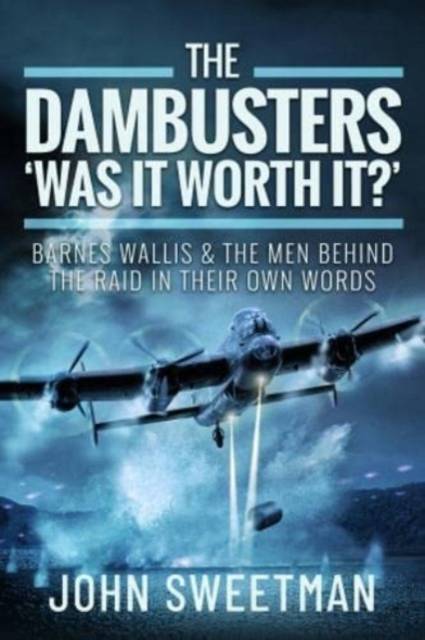
- Retrait gratuit dans votre magasin Club
- 7.000.000 titres dans notre catalogue
- Payer en toute sécurité
- Toujours un magasin près de chez vous
- Retrait gratuit dans votre magasin Club
- 7.000.0000 titres dans notre catalogue
- Payer en toute sécurité
- Toujours un magasin près de chez vous
The Dambusters - 'Was It Worth It?'
Barnes Wallis and the Men Behind the Raid in Their Own Words
John Sweetman
Livre relié | Anglais
34,95 €
+ 69 points
Description
On 16 May 1943, 617 Squadron's first mission saw 19 Avro Lancasters deploy bouncing bombs to breach the Möhne and Eder dams, inflicting significant damage on Nazi Germany's industrial Ruhr region.
On the evening of 16 May 1943, nineteen Avro Lancasters took off from RAF Scampton to undertake 617 Squadron's first offensive attack since its formation a few weeks earlier. Loaded with Barnes Wallis' newly designed bouncing bombs, the Bomber Command crews set course for their targets - the vital Möhne, Eder and Sorpe dams that served the Ruhr, the Third Reich's industrial heartland.
By the time the survivors began landing back at base at 03.11 hours the following morning, eight of the Lancasters had been shot down. However, both the Möhne and Eder dams had been breached, while the Sorpe was damaged. The flood waters that the attacks unleashed poured downstream, wreaking havoc on the surrounding countryside. Albert Speer, Hitler's Minister of Armaments and War Production, later wrote: "That night, employing just a few bombers, the British came close to a success which would have been greater than anything they had achieved hitherto with a commitment of thousands of bombers."
In 1990, the renowned historian and author Dr John Sweetman published his seminal work on the events before, during and after Operation Chastise. His book was the result of decades of research into the famous attack, in the course of which Dr Sweetman corresponded with or interviewed many of the individuals involved - from the scientists to senior officers, and from groundcrew to the very airmen who delivered Barnes Wallis' bouncing bombs to the dams.
Such was the relationships that developed over the years, Dr Sweetman became a close friend to many of these individuals and their families. Some of the information contained in the interview transcripts and letters he received was included in his original book; much more, however, was never used. This is particularly the case with the many letters and conversations which Dr Sweetman received or had after his book was first published - much of which adds to, or elaborates on, the narrative of the events in May 1943.
Dr John Sweetman has delved into his remarkable archive of material to present unseen sections of it here, for the historian or general reader, for the very first time.
On the evening of 16 May 1943, nineteen Avro Lancasters took off from RAF Scampton to undertake 617 Squadron's first offensive attack since its formation a few weeks earlier. Loaded with Barnes Wallis' newly designed bouncing bombs, the Bomber Command crews set course for their targets - the vital Möhne, Eder and Sorpe dams that served the Ruhr, the Third Reich's industrial heartland.
By the time the survivors began landing back at base at 03.11 hours the following morning, eight of the Lancasters had been shot down. However, both the Möhne and Eder dams had been breached, while the Sorpe was damaged. The flood waters that the attacks unleashed poured downstream, wreaking havoc on the surrounding countryside. Albert Speer, Hitler's Minister of Armaments and War Production, later wrote: "That night, employing just a few bombers, the British came close to a success which would have been greater than anything they had achieved hitherto with a commitment of thousands of bombers."
In 1990, the renowned historian and author Dr John Sweetman published his seminal work on the events before, during and after Operation Chastise. His book was the result of decades of research into the famous attack, in the course of which Dr Sweetman corresponded with or interviewed many of the individuals involved - from the scientists to senior officers, and from groundcrew to the very airmen who delivered Barnes Wallis' bouncing bombs to the dams.
Such was the relationships that developed over the years, Dr Sweetman became a close friend to many of these individuals and their families. Some of the information contained in the interview transcripts and letters he received was included in his original book; much more, however, was never used. This is particularly the case with the many letters and conversations which Dr Sweetman received or had after his book was first published - much of which adds to, or elaborates on, the narrative of the events in May 1943.
Dr John Sweetman has delved into his remarkable archive of material to present unseen sections of it here, for the historian or general reader, for the very first time.
Spécifications
Parties prenantes
- Auteur(s) :
- Editeur:
Contenu
- Nombre de pages :
- 304
- Langue:
- Anglais
Caractéristiques
- EAN:
- 9781399063814
- Date de parution :
- 30-07-24
- Format:
- Livre relié
- Format numérique:
- Genaaid
- Dimensions :
- 155 mm x 234 mm
- Poids :
- 564 g

Les avis
Nous publions uniquement les avis qui respectent les conditions requises. Consultez nos conditions pour les avis.






